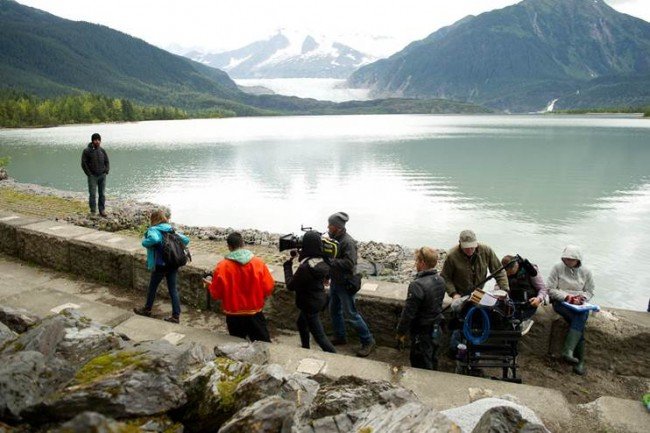
The production began in Anchorage for nine days. Anchorage residents opened their homes for rehearsing, eating and filming. On the 10th day of filming, the crew packed up their Anchorage production and embarked on a road trip that would span all of Southeast Alaska. For the next four weeks, the company’s home consisted of a caravan of cars, RVs, trucks and one decommissioned airport shuttle. These were the available vehicles around Anchorage that rented for cheap and met our needs.
We started with three days in Denali National Park. After this, the production drove the immense and extremely desolate Denali Highway where they stopped at mile 80 to stay at Gracious House—with no phones, no emails, and an airplane for emergencies and generator electricity.
Our most challenging scene was our captivating bear scene. I wrote it into the original script, hoping we could just “find a bear in Alaska.” And we did. The Anchorage Wildlife Conservation Center not only had bears, but all sorts of animals. These were wild but not free, and though completely untrained, accustomed to being fed and seeing people. Joe and I went to visit the AWCC director, Mike Miller, and Mike arranged a day during the shoot in which we could come film a grizzly bear named Joe Boxer (JB) with our actors. On that day, Miller drove the actors and the camera team, seated in the shovel of a front loader tractor, into the bear enclosure. Mike dropped them off and got out with a bucket of fish and a pitchfork. Mike lured JB with the smell of food. As JB neared the crew, Mike threw fish over and beyond JB, who would turn away, go eat and then wander back for more. Hillary filmed the actors while JB walked round and round. Key grip Garrett Cantrell looked at Mike and said, “What happens when we run out of fish?”

Ella Purnell strides lakeside at Mendenhall Glacier in Tongass National Forrest near Juneau, followed by DP Hillary Spera handheld, with AD Chris Carroll standing watch.
For the final two weeks, the team boarded the M.V. Kennicott ferry vessel run by the Alaska Marine Highway Service and embarked on the actual two day journey from Whittier to Juneau, filming on the moving ship with passengers as extras along the way. I had begun to speak to the AMHS on my very first scout to Alaska. Like with Denali, we made friends and laid out our objectives for the movie, and they gave us a working boat that we could film on for two days, complete with passengers and crew. A camera-ready live boat! Not only was the trip very scenic, but the crew was also transported to Juneau, vehicles and equipment on board.
The final week of shooting was completed in Juneau, hemmed in by spectacular mountains and sea. In front of the picturesque Mendenhall Glacier, filming was interrupted by a family of black bears, a mother and two cubs, whose curiosity had led them to the set. The crew had by this time encountered bears, moose, caribou, wolves, dall sheep and even bald eagles.
You need preparation, innovation and luck to conquer any production—especially an outdoor production, and especially an outdoor Alaska production. Of course, moviemaking is easier if you are not designing sets, erecting structures and painting walls along the way.
Selling Alaska
I have effectively become an unpaid tourism board ambassador for Alaska, which is much more than just mountain men, bear attacks and the Arctic National Refuge. Many Alaskans have thanked me for finally showing the beauty of Alaska as a unique home of American people: cities and villages in the greatest outdoors, instead of a rugged, frightening backwater of unsophisticated ruffians living among wildlife.
Alaskans are smart, tough, resourceful, independent, unique and friendly. Not only were nearly all of our locations free of charge, but we also had visitors bring us whole smoked salmon, take us to dinner, drive actors, house our crew and populate our scenes. The native populations, including the Haida Indians, are numerous with a fantastic history, art and culture. Totem poles, carvings, whalebone, hides, drawings and paintings are an inherent part of the wealth of the state. Also, the film industry in Alaska was in full swing as we wrapped production on Wildlike, with a tax credit offering up to 44 percent on qualified expenses for a string of feature films, numerous TV shows and commercials, as well as a strong crew base, equipment and scouts. Unfortunately, that particular tax credit has ended, but the film community is strong and the production work will continue.
Today I have a relationship with Alaska that will last a lifetime. My address book and Facebook are populated with Alaskans whom I have already reconnected with at the Anchorage Film Festival. By embracing my location and the outdoors as a filmmaker, the location drove the story forward, nourished the movie, enabled an efficient production and bore a fantastic product. Now I am focused on where to go for feature number two—and then I’ll find the story. MM
Wildlike opens in theaters on September 25, 2015, courtesy of Killer Films and Tandem Pictures.
Share:

